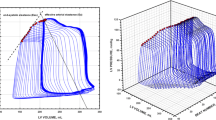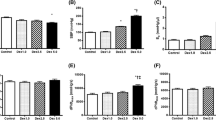Summary
The independence of indices of contractility to Starling effects was tested in 6 closed-chest dogs. After vagal and beta-receptors blockade, indices calculated with total left ventricular isometric pressure (TP), were shown to be strongly dependent of rises in end-diastolic pressure (LVEDP) induced by dextran infusion. At LVEDP of 14.6±1.5, 22.2±1.1 and 32.8±1.5 mm Hg (±SEM), the peak value of velocity of the contractile elements calculated with total pressure (peak VCE, TP) diminished by 21, 40 and 50%, and the extrapolated value of VCE, TP at zero total pressure (Vmax, TP) diminished by 15, 30 and 44%. In contrast, indices calculated with developed pressure (DP=TP-LVEDP) at the same LVEDP were much less influenced, particularly the extrapolated value of VCE, DP at zero DP (Vmax, DP5) and (peakdP/dt)/DP did not significantly change.
During angiotensin infusion, expected decreases in TP indices secondary to LVEDP rises were partially masked by simultaneous increases in contractility, and DP indices tended to rise. On the other hand, with minimal changes in LVEDP, as during calcium injection and paired stimulation, increases in TP and DP indices demonstrate inotropic effects equally well.
Our study also shows that, besides Vmax calculated with DP, the instantaneous ratio of peakdP/dt and DP can also be proposed as a simpler and thus more convenient index of contractility independent of volume changes.
Similar content being viewed by others
References
Falsetti, H. L., Mates, R. E., Greene, D. G., Bunnell, I. L.: Vmax as an index of contractile state in man. Circulation43, 467–479 (1971)
Graham, T. P., Jarmanaki, J. M., Canent, R. V., Anderson, P. A. W.: Evaluation of left ventricular contractile state in childhood. Normal values and observations with a pressure overload. Circulation44, 1043–1052 (1971)
Grossman, W., Haynes, F., Paraskos, J. A., Saltz, S., Dalen, J. E., Dexter, L.: Alterations in preload and myocardial mechanics in the dog and in man. Circulat. Res.31, 83–94 (1972)
Hugenholtz, P. G., Ellison, R. C., Urschel, C. W., Mirsky, I., Sonnenblick, E. H.: Myocardial force-velocity relationships in clinical heart disease. Circulation41, 191–202 (1970)
Levine, H. J., Britman, N. A.: Force-velocity relations in the intact dog heart. J. clin. Invest.43, 1383–1396 (1964)
Mason, D. T., Spann, J. F., Jr., Zêlis, R.: Quantification of the contractile state of the intact human heart. Amer. J. Cardiol.26, 248–257 (1970)
Mehmel, H., Krayenbuehl, H. P., Rutishauser, W.: Peak measured velocity of shortening in the canine left ventricle. J. appl. Physiol.29, 637–645 (1970)
Mehmel, H. C., Krayenbuehl, H. P., Wirz, P.: Isovolumic contraction dynamics in man according to two different muscle models. J. appl. Physiol.33, 409–414 (1972)
Mirsky, I., Ellison, R. C., Hugenholtz, P. G.: Assessment of myocardial contractility in children and young adults from ventricular pressure recordings. Amer. J. Cardiol.27, 359–367 (1971)
Nejad, N. S., Klein, M. D., Mirsky, I., Lown, B.: Assessment of myocardial contractility from ventricular pressure recordings. Cardiovasc. Res.5, 15–23 (1971)
Noble, M. I. M.: Problems concerning the application of concepts of muscle mechanics to the determination of the contractile state of the heart. Circulation45, 252–255 (1972)
Noble, M. I. M., Bowen, T. E., Hefner, L. L.: Force-velocity relationship of cat cardiac muscle, studied by isotonic and quick-release techniques. Circulat. Res.24, 821–833 (1969)
Parmley, W. W., Sonnenblick, E. H.: Series elasticity in heart muscle. Its relation to contractile element velocity and proposed muscle models. Circulat. Res.20, 112–123 (1967)
Parmley, W. W., Chuck, L., Sonnenblick, E. H.: Relation of Vmax to different models of cardiac muscle. Circulat. Res.30, 34–43 (1972)
Parmley, W. W., Diamond, G., Tomoda, H., Forrester, J. S., Swan, H. J. C.: Clinical evaluation of left ventricular pressures in myocardial infarction. Circulation45, 358–366 (1972)
Peirce, E. C., Kent, B. B., Patterson, R. E., Temples, J.: A curious approximate construction for VCE, max. J. appl. Physiol.28, 507–509 (1970)
Raff, U., Stauber, W., Kissling, G.: The reliability of different indices of myocardial contractility in the heart of closed-chest dogs. Basic Res. Cardiol.69, 58–73 (1974)
Ross, J., Jr., Covell, J. W., Sonnenblick, E. H., Braunwald, E.: Contractile state of the heart characterized by force-velocity relations in variably afterload and isovolumic beats. Circulat. Res.18, 149–163 (1966)
Shaper, W. K. A., Lewi, P., Jageneau, A. H. M.: The determinants of the rate of changes of the left ventricular pressure (dP/dt). Z. Kreisl.-Forsch.46, 27–41 (1965)
Sonnenblick, E. H.: Force-velocity relations in mammalian heart muscle. Amer. J. Physiol.202, 931–939 (1962)
Sonnenblick, E. H.: Series elastic and contractile elements in heart muscle: Changes in muscle length. Amer. J. Physiol.207, 1330–1338 (1964)
Sonnenblick, E. H., Parmley, W. W., Urschel, C. W.: The contractile state of the heart as expressed by force-velocity relations. Amer. J. Cardiol.23, 488–503 (1969)
Taylor, R. R., Ross, J., Jr., Covell, J. W., Sonnenblick, E. H.: A quantitative analysis of left ventricular myocardial function in the intact sedated dog. Circulat. Res.21, 99–115 (1967)
Urschel, C. W., Henderson, A. H., Sonnenblick, E. H.: Model dependency of ventricular force-velocity relations: Importance of developed pressure. Fed. Proc.29, 719, Abs. (1970)
Wolk, M. J., Keefe, J. F., Bing, O. H. L., Finkelstein, L. J., Levine, H. J.: Estimation of Vmax in auxotonic systoles from the rate of relative increase of isovolumic pressure: (dP/dt)/KP. J. clin. Invest.50, 1276–1285 (1971)
Author information
Authors and Affiliations
Additional information
This work was supported in part by Grant 20022 from the Fonds de la Recherche Scientifique Médicale.
Rights and permissions
About this article
Cite this article
Cosyns, J., Gutierrez-Miranda, M., Reyns, P. et al. Superiority of developed over total pressure for heart contractility indices in dogs. Pflugers Arch. 362, 165–171 (1976). https://doi.org/10.1007/BF00583643
Received:
Issue Date:
DOI: https://doi.org/10.1007/BF00583643




